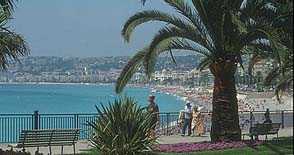|
Provence
Region, SE France, comprising the departments of Alpes-de-Haute-Provence,
Var, and Bouches-du-Rhône and parts of the departments of Vaucluse and
Alpes-Maritimes. Provence is bordered on the E by Italy, on the S by
the Mediterranean Sea, and on the W by the Rhône R. The area abounds
with flower fields, vineyards, orchards, and olive and mulberry
groves. Along the seacoast is the French Riviera and the ports of
Marseille and Toulon. The modern inhabitants of Provence preserve a
distinct regional character, as well as their own language
The region originally formed part of a Roman province, Provincia
Romana, constituted about 120 BC. It passed successively into the
possession of several ancient Germanic peoples, the Visigoths, the
Ostrogoths, and the Frankish kings. In AD 879 the area was
incorporated into the kingdom of Provence, sometimes called Cisjurane
Burgundy, and in the 10th century into the kingdom of Arles. After
being ruled by the house of Anjou from about 1245 to 1482, the region
came into the possession of King Louis XI of France, and in 1486 it
was annexed to the French Kingdom. Provence was a province of France
until the French Revolution, after which the area was distributed
among several departments.
PROVENÇAL LANGUAGE
Also Occitan or Languedoc, Romance language spoken in the southern
third of France, used by about one-fourth of the French population.
Provençal developed an eminent literature in the 11th to 15th
centuries, including the poems of the troubadours. It extended
significantly north of its present speech region, and its standard
literary dialect bridged many local dialects. This literary language
began to wane after France established dominion over the south in the
14th century. In the 19th century the poet Frédéric Mistral led a
movement to establish a modern standard literary Provençal. In a move
to preserve regional heritage and culture, the French government in
1993 instructed state schools to start teaching Provençal and other
indigenous languages.
Provençal dialect groups include Limousin and Auvergnat in
south-central France, Languedoc and Provençal proper in the
Mediterranean area, and Gascon (sometimes considered a separate
language) in southwest France. Settled by the Romans earlier than the
rest of France, their Latin-derived speech was less influenced than
northern French by Frankish and other Germanic languages. Although
Provençal has been increasingly influenced by French, its structure is
closer to that of Spanish and Catalan. The term Franco-Provençal
refers to a distinctive group of dialects spoken northeast of the
Provençal area, extending slightly into Switzerland and Italy.
PROVENÇAL LITERATURE
Vernacular Latin literature written in southern France from about the
9th to the 15th century.
The earliest attempts at composition in the Provençal language
probably were made by priests and monks in the 9th century. To arouse
the religious sympathies of the people, they composed, or translated
from the Latin into the vulgar idiom, prayers, hymns, pious tales,
allegories, and legends of saints. At the end of the 11th century
Provençal poetry was greatly stimulated by the religious wars of the
Crusades and the introduction of the institution of chivalry.
Provençal literature was essentially poetic. Its prose works are of
little importance; later, in the 14th and 15th centuries, prose works
became more numerous and included scientific, juridical, philological,
and other works. Drama was not cultivated. The only productions that
might come under drama are pieces on pious subjects in dramatized
form, such as the Mystery of the Passion and the Marriage of the
Virgin. 
Poetry of the Provençal troubadours began appearing in the early 12th
century and reached its fullest expression in three poets writing at
the end of the century: Bertran de Born (c. 1140–1215), Arnaud Daniel
(c. 1150–1210), and Guiraut de Bornelh (1150?–1220). Within just a few
generations this poetry developed into a complicated art form so
perfect technically that in the 13th century Provençal was considered
by some to be the most suitable language for lyric poetry. 
In this poetry the lady, usually aristocratic and married, is
separated from her lover (the poet) for various social, geographic, or
even psychic reasons; the poet, in singing of his love, tries to reach
an overwhelming sentiment, which he calls joie ("joy, happiness").
Provençal poetry expresses a sensuous love quite opposed to the
traditional Christian concept.
The two distinguishing characteristics of Provençal versification are
the rhyme and the syllabic accent. The great number of final syllables
of the same sound in the declensions and conjugations of the language
offered great ease of rhyming. With the war against the Albigenses in
the 13th century and the establishment of French domination in the
south, Provençal poetry began to decline. In the following centuries
few Provençal works were worthy of notice. In the 19th century,
however, a new poetic activity grew up, beginning with the poet
Jacques Jasmin (1798–1864), and after him Frédéric Mistral, a poet of
great genius and one of the founders of the Félibrige, a society
dedicated to reviving the use of Provençal; Théodore Aubanel
(1829–86); and others. Poetic festivals have been introduced to aid
the movement, and in 1993 the French government, recognizing the
importance of regional culture, instructed state schools to begin
teaching Provençal and other regional languages.
|





